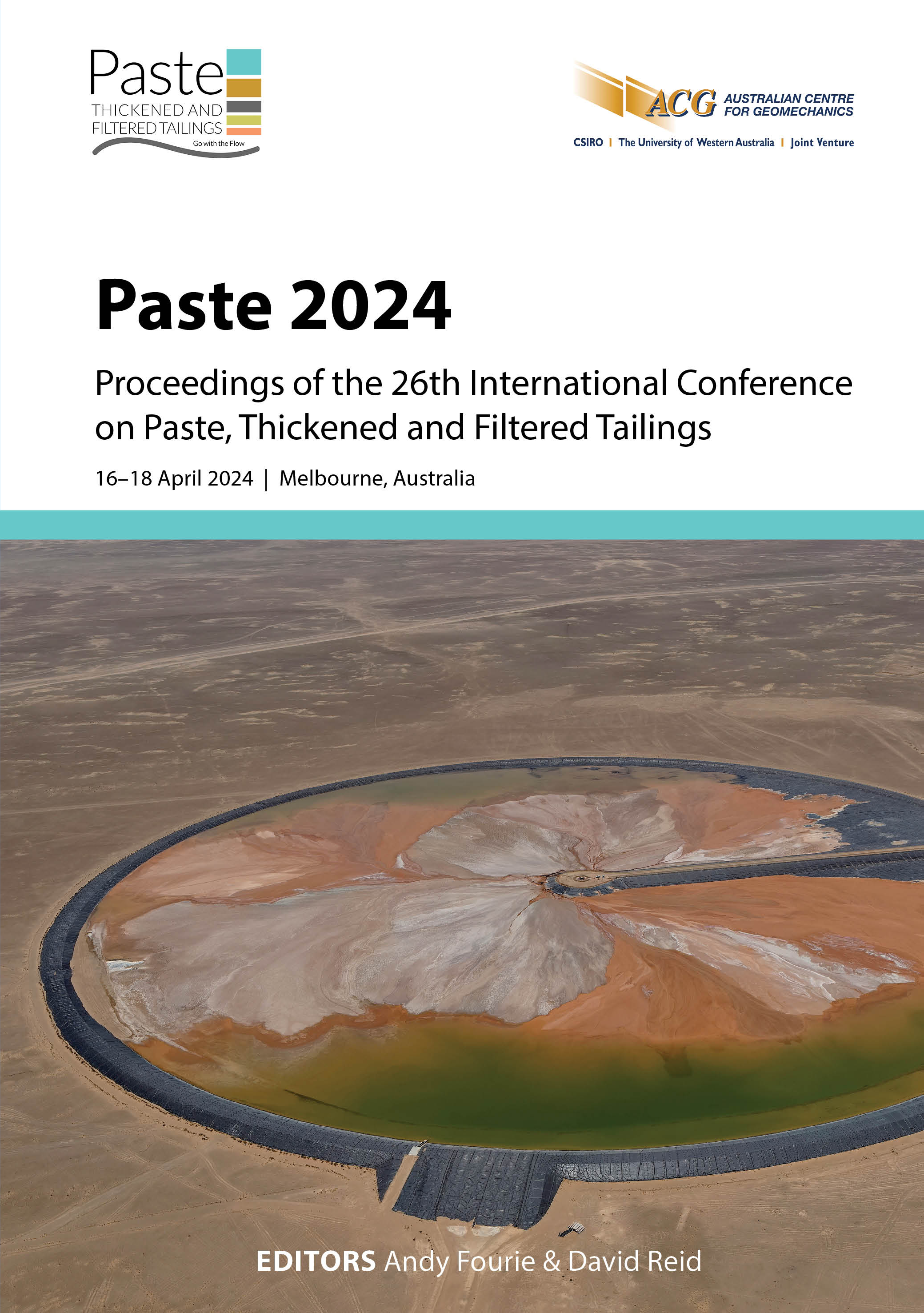The place for filtered tailings and stacking in the search for safe and sustainable tailings management

|
Authors: Amoah, N |
DOI https://doi.org/10.36487/ACG_repo/2455_0.01
Cite As:
Amoah, N 2024, 'The place for filtered tailings and stacking in the search for safe and sustainable tailings management', in AB Fourie & D Reid (eds), Paste 2024: Proceedings of the 26th International Conference on Paste, Thickened and Filtered Tailings, Australian Centre for Geomechanics, Perth, pp. 3-24, https://doi.org/10.36487/ACG_repo/2455_0.01
Abstract:
Tailings production, storage and management are integral parts of mineral processing operations, but tailings storage facility (TSF) failures have become a tragic part of the minerals processing industry. The amount of water in the tailings material deposited (in slurry form) and in the TSFs during operation are common factors in many TSF disasters, as the tailings and associated water can flow freely when a breach of containment occurs. In recent years, there has been intensive debate and interest in improved and alternative methods of tailings management, such as thickened paste and filtered tailings. However, the shift to low water content approaches such as filtered tailings storage (often termed dry stacking) continues to be hampered by uncertainties and misunderstandings on the issues and benefits in terms of feasibility, engineering performance, the scale of operation, cost effectiveness etc. The paper discusses the place for filtered tailings by providing practical insights obtained from the development of what is currently the largest filtered tailings storage facility (FTSF). Design considerations from dewatering processes of thickening and filtration, material handling, disposal, and operation management of the FTSF are discussed. Key learnings on design process, performance criteria, in situ behaviour of filtered tailings, operational control requirements and cost are presented to illustrate the benefits, issues, and applicability of this tailings management option. The paper demonstrates that tails filtration and dry stacking are feasible in terms of engineering performance and scale of operation. Advancements in filtration technology, material handling and disposal equipment have made it suitable for high throughput operations with reduced risks. Careful design considerations of tailings material characteristics and application of operating discipline result in cost-effective FTSF operation. Filtered tailings deposited in a partially saturated or unsaturated state, maintain this state with low risk of water table developing within the FTSF. Tailings filtered to high moisture contents and deposited into the FTSF tend to maintain a saturated state over time and should be controlled to the minimum during operation. Operating costs, although higher than conventional wet tailings management, are still reasonable when lifecycle risks and costs are considered. In low rainfall areas or where conventional wet tailings failure risks are high, filtered tailings and dry stacking should be explored.
Keywords: filtered tailings, dry stack, unsaturated
References:
Amoah, N 2019, ‘Large scale tailings filtration and dry stacking at Karara Iron Ore Magnetite operation’, Proceedings of Tailings and Mine Waste 2019, The University of British Columbia, Vancouver.
Amoah, N, Dressel, W & Fourie, AB 2018, ‘Characterisation of unsaturated geotechnical properties of filtered magnetite tailings in a dry stack facility’, in RJ Jewell & AB Fourie (eds), Paste 2018: Proceedings of the 21st International Seminar on Paste and Thickened Tailings, Australian Centre for Geomechanics, Perth, pp. 375–388,
1805_31_Amoah
Cacciuttolo, C & Marinovic, A 2022, ‘Sustainable management of thickened tailings in Chile and Peru: a review of practical experience and socio-environment acceptance’, Sustainability, vol. 14, no. 17.
Crystal, C, Hore, C & Ezama, I 2018, ‘Filter press dry stacking: design considerations based on practical experience’, Proceedings of Tailings and Mine Waste 2018, Colorado State University, Keystone.
Davies, M 2011, ‘Filtered dry tailings – the fundamentals’, Proceedings of Tailings and Mine Waste 2011, The University of British Columbia, Vancouver.
Fredlund, DG & Rahardjo, H 1993, Soil Mechanics for Unsaturated Soils, John Wiley & Sons, New York.
Hahn, J 2019, ‘Tailings dewatering with increased filtration rates and lowest filter cake moisture for filtered tailings stacking’, in AJC Paterson, AB Fourie & D Reid (eds), Paste 2019: Proceedings of the 22nd International Conference on Paste, Thickened and Filtered Tailings, Australian Centre for Geomechanics, Perth, pp. 245–257,
ACG_rep/1910_16_Hahn
© Copyright 2025, Australian Centre for Geomechanics (ACG), The University of Western Australia. All rights reserved.
View copyright/legal information
Please direct any queries or error reports to repository-acg@uwa.edu.au
View copyright/legal information
Please direct any queries or error reports to repository-acg@uwa.edu.au
